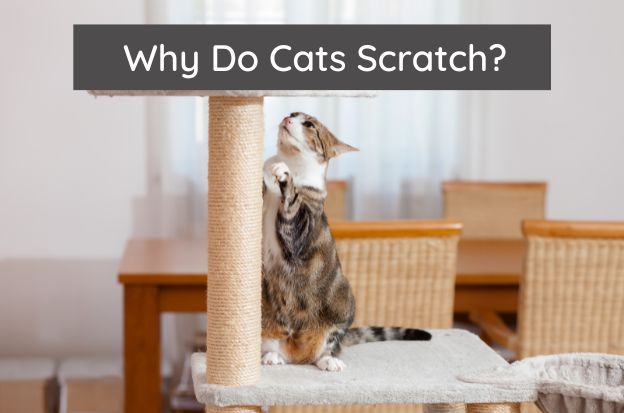
Why Do Cats Scratch?
Cats are particularly expressive creatures, and they are constantly expressing their emotions. For instance, consider purring. A cat’s purr is commonly associated with enjoyment, but cats purr for various reasons. The same is true for scratching. Scratching is just one of several bizarre feline behaviours. The frequent cat behaviour is perfectly normal and healthy. In fact, rather than attempting to discourage cats from scratching, cat parents encourage this instinctual behaviour.
You should only be concerned if the scratching becomes destructive. To differentiate between normal and destructive scratching, you should understand the reasons behind your feline’s behaviour. When cats begin scratching places that we feel are inappropriate, like the sofa, couches, flower pots, etc., this makes it a destructive behaviour.
Coming down to the main question, why? Scratching is an inherent cat habit necessary for their physical and emotional well-being. Have a look at these reasons in detail
7 Reasons Why Your Cat Scratch
1. Necessary claw motion as a hunch for hunting and climbing
Cats are natural hunters, and their claws are used to grasp and hold prey. They also use this action to strengthen the forelimb muscles and spine in anticipation of hunting.
2. Expressing emotions
Cats scratch to release stress and become stimulated or aroused. Have you ever witnessed your feline walk carefully by another cat in your house and then start scratching? Scratching allows the cat to express their annoyance. Have you ever seen your cat clawing as soon as you get home? Scratching is a show of joy in this scenario because your cat is contented to see you.
3. Communication and marking
Cats scratch to communicate with each other. They leave fragrance and visible traces when striking. Their paw pads contain scent glands, which release odours when they scratch to alert other cats to their presence. When cats scratch items, they create little gouges that serve as visual cues to other cats in the area.
4. Grooming
Some cats do so to cope with stress/boredom. Scratching is known to release endorphins, which help relieve tension. So when a nervous cat finds solace in it, it might become a habit. Also, cats may respond to a change in routine or surroundings by excessively scratching. If you move into a new residence or introduce a new family member or pet, your cat may respond to it by extensive scratching.
5. Nail care
Scratching on an object removes the decaying outer sheath of the nail and exposes the healthy new growth beneath. As evidence, you will find several crescent moon-shaped nail sheaths around your furniture or drywall, where your cat generally scratches.
6. Stretching
If your cat goes straight to her scratching station after a nap, it’s definitely getting an after-nap stretch. Scratching allows your cat to extend her claws and feet; if she has an elevated scratching post, she may also stretch her entire body.
7. Exercising
Scratching can also be considered exercise since it allows your cat to activate her muscles—especially if she can dig her nails in and obtain a firm grip while pushing and pulling.
The reasons summarized above are pretty much the ones behind your cat’s scratching behaviour. More or less, scratching is a feline antic that is common to almost all cats. So, you should not worry about it. Also, you cannot prevent your cat from scratching because there is nothing you can do about it.
Nevertheless, if the scratching becomes destructive, you can moderate the behaviour by limiting the access to areas/things where your cat scratches. Always provide your cat with a variety of suitable scratching surfaces and textures. Scratchers are available in a variety of shapes, sizes, and materials.
Which scratching surface?
If your cat is scratching furniture, investigate where your cat excessively scratches to determine your cat’s ideal scratching setting. Is it vertical? What is the most similar surface? Purchase scratching posts that are identical to your cat’s favourite scratching arrangement. Place an eligible scratching post near an unacceptable object based on your cat’s preferences.
It is important to explore various surfaces and scratchers to learn which your cat prefers. Scratching posts or pads made of sisal rope, cardboard, wood, or sisal fabric are some preferable examples.
It is preferable to have both lateral and vertical scratching surfaces available. The vertical one will allow your cat to stretch its whole body.
Scratchers should be strong and not unsteady or fall over when scratched by your cat. They should be pretty tall. To receive a full-body stretch, your cat should be capable of standing on its hind legs and straight with its body up the side of the post.
Explore Cat Food Options
A few more tips
- Do not force your cat to use its claws across the scratching post. You would dislike being pushed to do things. So would your cat. This may frighten your cat and cause it to reject the scratcher entirely.
- Make the scratching locations more enticing. You can do this by attaching some interactive toys to the post or placing a catnip near the scratching post.
- You may also give your cats food and play with them on or around the scratcher to help them form a pleasant association with it.
- Reward your cat for scratching their scratchers with a treat or a pet. Remember that what one cat finds rewarding may not be encouraging to another, so praise your cat in a way that it enjoys.
- Regular toenail cutting prevents destructive clawing and keeps her nails from becoming snagged or ripped on anything. For instance, clip one nail and provide a treat. If your cat remains calm, cut the second nail while eating; if it remains calm, progress to trimming five nails in one session.
- If your cat is reluctant to claw trimming or having her paws touched, a trained professional can assist you in teaching your cat to tolerate and even enjoy nail trimming.

